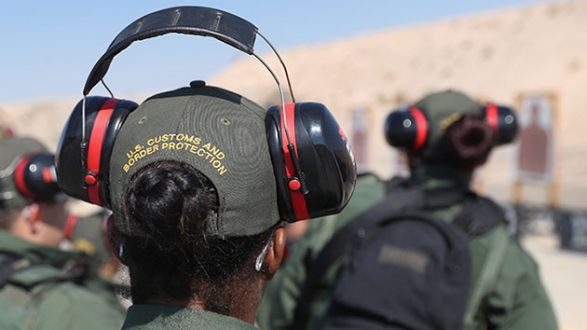
 John Moore/Getty Images(SAN DIEGO) — U.S. Customs and Border Protection (CBP) began physically testing the southwest border wall prototypes this week, according to a spokesperson for the department.
John Moore/Getty Images(SAN DIEGO) — U.S. Customs and Border Protection (CBP) began physically testing the southwest border wall prototypes this week, according to a spokesperson for the department.
The start of the official testing period was Nov. 27, but physical tests began Monday, said Carlos Diaz, CBP’s public affairs branch chief for the southwest border.
Construction of eight wall prototypes in the San Diego sector were completed on Oct. 26. Six companies were chosen to build eight sample walls — four made of concrete and four constructed of “other materials.”
President Donald Trump made the southern border wall between Mexico and the United States the calling card of his presidential campaign. “Build the wall” became a familiar chant at all of Trump’s campaign rallies, and stopping illegal immigration was one of the candidate’s top selling points.
The prototypes are the first steps in CBP’s efforts to build a wall, although administration officials have acknowledged that a future wall is unlikely to stretch from “sea to shining sea,” despite Trump’s initial promise to cover the entire border.
Last week, CBP officials began training, safety and security procedures, as well as scheduling to set up the testing.
The physical testing will include attempts to scale and breach the prototypes. Officials will use items such as jackhammers, saws and hydraulic tools to attempt to breach them.
During the procurement process, the companies were required to build the walls at least 6 feet deep. The depth of the walls was evaluated during the construction process, according to Diaz.
All eight prototypes were required to be 18 to 30 feet high and designed to deter illegal crossings.
The prototypes were built side by side to the current secondary wall in San Diego, which already has a primary and secondary barrier.
Officials said the current barriers need to be modernized.
Over the past three years, the existing infrastructure in San Diego has been breached nearly 2,000 times, according to Roy Villareal, the deputy chief patrol agent of the San Diego Sector.
He said that’s a “testament” to the need for new wall structures.
“If you go back to the late ’80s, the border was completely overrun. There were daily robberies, rapes, assaults, vehicle thefts, high-speed pursuits, people getting killed along the border in staggering numbers,” said Villareal, speaking to ABC News in front of the prototypes. “That has all curtailed as a result of investment in border security. That has curtailed as a result of what you see here today.”
However, critics and Democratic lawmakers said the wall is a waste of time and money.
“Let me be clear: Trump’s border wall is a waste of money, and I will block funding for it,” said Sen. Kamala Harris, D-Calif., in a July tweet.
Rep. Barbara Lee, D-Calif., tweeted in March that “Trump’s wall is a waste of money and an insult to our values,” with the hashtags “#NoBanNoWall” and “#JointSession.”
“Across the southwest, border residents and local stakeholders like mayors and sheriffs are firmly opposed to President Trump’s folly endeavor, based on economic, environmental and humanitarian impacts,” Lorella Praeli, director of immigration policy and campaigns at the American Civil Liberties Union, said in a July statement.
On Tuesday, CBP announced that during fiscal year 2017, there were a total of 310,531 apprehensions by U.S. Border Patrol nationwide — the lowest total number in at least 17 years.
Of those apprehensions, nearly 98 percent were along the southwest border.
In August, the Department of Homeland Security (DHS), which oversees CBP, issued a waiver to certain laws, regulations and other legal requirements to expedite the prototype construction process.
The waiver allowed CBP to disregard laws such as the Endangered Species Act, the Clean Air Act and the Safe Drinking Water Act, along with many more.
However, CBP said it will be committed to environmental and cultural stewardship.
The physical tests are expected to take place over the next two weeks.
Evaluators are going through a “very regimented process” during this assessment phase “to ensure, when it’s completed, we have the best information available,” said Diaz.
CBP is evaluating all the breach attempts and how long they take.
Everything is being complied and documented for the evaluation process that comes afterward, according to CBP.
Copyright © 2017, ABC Radio. All rights reserved.










